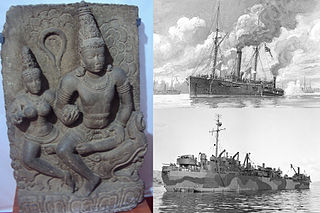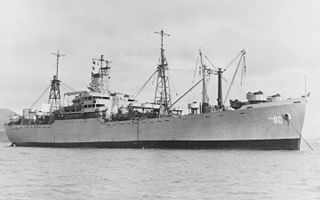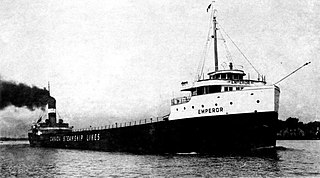Holland America Line N.V. (HAL) is an American-owned cruise line, a subsidiary of Carnival Corporation & plc headquartered in Seattle, Washington, United States.

USS Snook (SS-279), a Gato-class submarine, was the first ship of the United States Navy to be named for the common snook, an Atlantic marine fish that is bluish-gray above and silvery below a black lateral line.

The Blue Star Line was a British passenger and cargo shipping company formed in 1911, being in operation until 1998.
Several ships have been named Innisfallen, the name being derived from the island of Innisfallen in County Kerry and often given to vessels serving the southerly coasts of Ireland. Five served on the Irish Sea route between Cork and Fishguard, from 1896 onwards: two of these were war casualties whilst the remainder have been either scrapped or renamed and sold to new owners.

Two ships in the United States Navy have been named USS Varuna for Varuna, the Vedic god of oceans and rivers and keeper of the souls of the drowned.

Type C2 ships were designed by the United States Maritime Commission (MARCOM) in 1937–38. They were all-purpose cargo ships with five holds, and U.S. shipyards built 328 of them from 1939 to 1945. Compared to ships built before 1939, the C2s were remarkable for their speed and fuel economy. Their design speed was 15.5 knots (28.7 km/h), but some could make 19 knots (35 km/h) on occasion. The first C2s were 459 feet (140 m) long, 63 feet (19 m) broad, and 40 feet (12 m) deep, with a 25-foot (8 m) draft. Later ships varied somewhat in size. Some, intended for specific trade routes, were built with significant modifications in length and capacity.
SS Republic may refer to the following ships:
SS Princess Alice may refer to the following ships:

SS Washingtonian was a refrigerated cargo ship launched in 1913 by the Maryland Steel of Sparrows Point, Maryland, near Baltimore, as one of eight sister ships for the American-Hawaiian Steamship Company. When completed, she was the largest cargo ship in the US registry. During the United States occupation of Veracruz in April 1914, Washingtonian was chartered by the United States Department of the Navy for service as a non-commissioned refrigerated supply ship for the US fleet stationed off the Mexican coast.

Merida was a steam cargo ship built in 1906 by William Cramp & Sons of Philadelphia for New York & Cuba Mail Steamship Co., owned and operated by Ward Line, with intention of serving their New York to Havana route.
Jean Marie was a 964 GRT coaster that was built in 1922 by F Schichau GmbH, Elbing, Germany as Tertia for German owners. A sale in 1925 saw her renamed Hornland. In 1926, a further sale saw her renamed Taube. She was seized by the Allies in May 1945, passed to the Ministry of War Transport (MoWT) and was renamed Empire Contour. In 1946, she was transferred to Belgium and renamed Jean Marie. She was sold into merchant service, serving until 1951 when she sank after her cargo shifted.
A number of steamships were named Riga, including:
A number of steamships were named Santa Isabel, including –

SS (RMS) Douglas (III) – the third vessel in the line's history to bear the name – was a packet steamer which entered service with the London and South Western Railway in 1889 under the name Dora until she was purchased by the Isle of Man Steam Packet Company in 1901 for £13,500.
A number of motor vessels have been named Jupiter, including
SS Berlin may refer to one of the following ships

Lamport and Holt was a UK merchant shipping line. It was founded as a partnership in 1845, reconstituted as a limited company in 1911 and ceased trading in 1991.

SS Emperor was a steel-hulled Canadian lake freighter in service between 1911 and 1947. She was built between 1910 and April 1911 by the Collingwood Shipbuilding Company in Collingwood, Ontario, for Inland Lines, Ltd., of Midland, Ontario. She entered service on May 3, 1911. Emperor was sold to Canada Steamship Lines of Montreal, Quebec. Under the ownership of Canada Steamship Lines, she carried a wide variety of cargoes, but most frequently iron ore to Point Edward, Ontario, where it would be transported to Hamilton, Ontario, by train. After the opening of the fourth Welland Canal, Emperor carried the ore directly to Hamilton. She was involved in several accidents throughout her career.

Agwilines Inc was a passenger and cargo shipping company of New York City. Agwilines is short for Atlantic, Gulf & West Indies Steamship Inc. AGWI Lines group operated four main lines in the 1910s, 1920s and 1930s:
This page is based on this
Wikipedia article Text is available under the
CC BY-SA 4.0 license; additional terms may apply.
Images, videos and audio are available under their respective licenses.









